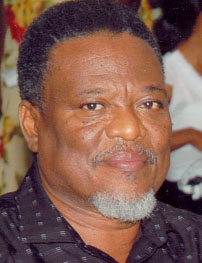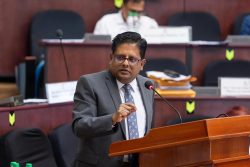 The government has no defined plans to privatize the power company in the medium term and says GPL hopes to reduce technical and commercial losses from 33.4% at the end of 2007 to 14.65% by 2012.
The government has no defined plans to privatize the power company in the medium term and says GPL hopes to reduce technical and commercial losses from 33.4% at the end of 2007 to 14.65% by 2012.
Prime Minister Samuel Hinds was responding to a question posed by PNCR-1G Member of Parliament Anthony Vieira, by way of Notice Paper No. 235, asking him to inform the National Assembly whether the present restructuring of the Guyana Power Light (GPL), including the severing of over 200 employees, will result in better efficiency at GPL.
“Yes, that is our intention, our purpose and our hope,” the prime minister responded. He said further that the restructuring “is aimed at reducing costs. This decision has been motivated by considerations of employees’ productivity such as employees per customer, employees per unit of energy sold and so forth…” The written answer was circulated at Thursday’s sitting of Parliament.
Vieira also asked whether the restructuring of GPL will result in a corresponding decrease in the cost of electricity to consumers.
 It will contribute to lowering costs, Hinds responded, but pointed out also that many other items contribute to costs such as fuel prices, wage settlements, and machinery and equipment costs. “Our aim is to provide electricity to customers in the Guyana situation at the lowest sustainable prices and we will continue in our efforts to reduce costs wherever possible,” the prime minister stated.
It will contribute to lowering costs, Hinds responded, but pointed out also that many other items contribute to costs such as fuel prices, wage settlements, and machinery and equipment costs. “Our aim is to provide electricity to customers in the Guyana situation at the lowest sustainable prices and we will continue in our efforts to reduce costs wherever possible,” the prime minister stated.
And Hinds said further that electricity (rather than line) losses are often categorized as technical and commercial, responding to Vieira’s question about what percentage of line losses is due to technical faults and what percentage is due to the theft of electricity.
The prime minister said further that a study by the consulting group Power Planning Associates (PPA) in 2006 had put technical (line) losses at 11.6% and commercial losses at 28.8%. Both categories of losses are now much lower with the latest audit report of PPA certifying the last 12 months average total losses (commercial and technical combined) as at December 2007 to be 33.4%, he revealed.
Hinds also explained that commercial losses include theft of electricity, meters reading low for any number of reasons, as well as problems from meter readings through to billings and receipts.
Some customers may fall off the active register even though they continue to receive electricity, Hinds noted, and while genuine errors can and do occur in these areas, there have been reports of scams and collusions between customers and a number of employees.
Meanwhile, a number of considered programmes are being implemented to reduce theft and other commercial losses starting with improved metering, including prepaid meters, new computer hardware and software featuring a consumer information system with many new checks, balances and internal controls.
Prime Minister Hinds said further that there are technical losses inherent in the flow of electricity through the transmission and distribution system. He observed that owing to low capital availability over the last thirty years or more, and economies at the time of installation and growth since, much of GPL’s system is overloaded, but investments planned in T&D will gradually lower technical losses.
Moreover, GPL’s Development and Expansion Programme 2008-2012 has set a target for technical and commercial losses to be reduced to 6.75% and 7.9% respectively for a total loss of 14.65% by 2012, the prime minister said.
He said too that the government has “no defined plans to privatize the Guyana Power and light Inc. through equity investment in the medium term,” responding to Vieira’s query whether the government had plans to sell its shares in GPL to private investors.
“The government has always desired widespread ownership of GPL across all categories of customers. The government has hoped and continues to hope that it would be a good learning experience for our people to be in the position of both owner and customer…,” the prime minister told the National Assembly.









